This site is made possible by its sponsors.
Please visit them!
RGB - Red green blue. An additive
system for representing the color spectrum
using combinations of red, green and blue. Used in theatrical lighting and in video
display devices.
the color spectrum
using combinations of red, green and blue. Used in theatrical lighting and in video
display devices.
|
Blue + Green = Cyan
|
Also see CMYK, colorblind, color wheel, primary colors, and secondary colors.
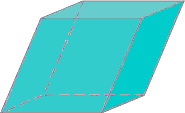
rhombohedron - A polyhedron with six two-dimensional faces, each a rhombus.
Also see mathematics, polygon, and vertex.
rhombus - An equilateral parallelogram. Each face of the rhombohedron above is a rhombus. A rhombus's area is the length of one side times the height (the distance between opposite sides). The plural form can be either rhombbuses or rhombbi.
(pr. ROM-bəs)
Also see polygon, quadrilateral, rectangle, rhombohedron, square, trapezium, and trapezoid.
rhopography - A genre comprising representations of trivial bric-a-brac, which may include such things as the remains of a meal, garbage on the floor, etc. Variations on this genre might include Dadaist readymades and works in the Arte Povera style.
Consider this sculpture:

Daniel Spoerri (Swiss, 1930-), Prose Poems, 1959-60, 27 1/.8 x 21 3/.8
x 14 1/4 inches (69.0 x 54.2 x 36.1 cm), Tate Gallery, London
-- an actual meal as abandoned on a board. See Fluxus and ontbijt.
Also see detritus.
rhyton - An ancient drinking horn, typically made from pottery or metal, and frequently having a base formed to represent a human or animal head, or a mythological creature. The term rhyton comes from the Greek verb meaning "to run through," and depictions of rhyta on Greek vases show that they were used to aerate wine.
(pr. RI:-tən or RI:-ton)
Among the other types of Greek vases are the alabastron, amphora, hydria, kantharos, krater, kyathos, kylix, lekythos, oinochoe, pelike, phiale, pinax, pithos, and pyxis.
Examples:
Greece, Rhyton in the shape of a lion, c. 1860-1780 BCE, terra cotta, height 7 1/2 inches, Fine Art Museums of San Francisco, CA.

Parthia, Rhyton, 2nd-1st centuries BCE,
ivory, Hermitage Museum,
St. Petersburg, Russia.

Iran, Rhyton terminating in the forepart of a panther,
1st century BCE-1st
century CE,
Parthian period, silver,
mercury gilding, height 10.8
inches (27.5 cm), Metropolitan Museum of Art, NY. See gilding.
![]()
Greek (Seleucid), Eastern Seleucid Empire,
50 BCE-50
CE,
Stag Rhyton, gilt
silver; inlaid
glass eyes, height
mounted: 10 7/16 x 18 1/8
x diameter (rim) 5 inches
(26.5 x 46 x diameter (rim) 12.7 cm), J. Paul Getty Museum, Malibu,
CA.
rib - A relatively slender, molded masonry arch that projects from a surface. In Gothic architecture, the ribs form the framework of the vaulting.
Examples:
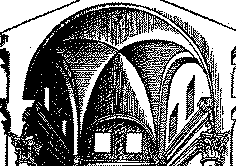
A Gothic cross
vault designed
by architect
Leon Baptiste Alberti (Italian, 1404-1472). Seen from this oblique point
of view, the ribs (or ogives)
resemble a drooping X. See a larger view.

Three alternating views of a rib vault in
an unidentified Gothic cathedral.
Also see ogive.
ribbed vault - See vault.
ridgepole - In architecture, the horizontal beam at the ridge of a roof, to which the upper ends of the rafters attach.
Also see post and lintel and trabeation.
 riffler
- A fine, small, usually double-edged and often rounded rasp.
The riffler is used in delicate shaping
and finishing of a carving.
Rifflers are made for work in wood,
metal,
riffler
- A fine, small, usually double-edged and often rounded rasp.
The riffler is used in delicate shaping
and finishing of a carving.
Rifflers are made for work in wood,
metal, ![]() and
stone in a variety of sizes and shapes, some of which
are pictured here. Files
are generally more finely abrasive
than rifflers. Surforms are
more like graters.
and
stone in a variety of sizes and shapes, some of which
are pictured here. Files
are generally more finely abrasive
than rifflers. Surforms are
more like graters.
Also see plaster.
right angle - A 90° angle. The third of the four angles below is a right angle. The first two are obtuse angles. The last is an acute angle.

Perpendicular lines or edges are at right angles to each other. The corners of every square and rectangle are right angles. Sheets of paper are cut, and moldings for picture frames are mitered so that their corners are right angles. A typical cross is formed by the intersection of two line segments at right angles to each other.
![]()

![]()
right brain - Refers to a theory in which the right side of the brain is the creative side, responsible for art and spatial comprehension, while the left side is responsible for reading, verbal, and mathematical sorts of tasks. Also see multiple intelligence theory.
rinceau - An ornamental design composed of undulating foliate vine motif.
(pr. ran-SOH)
Example:

Howard Pyle (American, 1853-1911), page decoration for the "Seven O'Clock"
chapter heading of his book, The Wonder Clock, 1887,
pen and ink.
Howard Pyle founded the "Brandywine School" of illustration.
Among his students were N.C. Wyeth, Maxfield Parrish, Violet
Oakley, Jessie Willcox Smith and Frank Schoonover.
Also see Art Nouveau.
 ripsaw - A long-bladed hand-held saw with teeth
designed for cutting wood in the
same direction as the grain
runs. Ripsaws have chisel-like
teeth that plow through the wood. By contrast, the teeth of crosscut saws are pointed to
cut wood fibers. Both types of teeth are bent out, or set, to
create a kerf that's wider
than the blade. Although the ripsaw seen here is a hand saw, ripsaw
blades are also available for use in circular
saws. Ripping with a hand saw demands a 60 degrees angle,
as shown.
ripsaw - A long-bladed hand-held saw with teeth
designed for cutting wood in the
same direction as the grain
runs. Ripsaws have chisel-like
teeth that plow through the wood. By contrast, the teeth of crosscut saws are pointed to
cut wood fibers. Both types of teeth are bent out, or set, to
create a kerf that's wider
than the blade. Although the ripsaw seen here is a hand saw, ripsaw
blades are also available for use in circular
saws. Ripping with a hand saw demands a 60 degrees angle,
as shown.
Also see hacksaw.
risers - In lost-wax casting, risers are channels through the mold which allow air to escape as molten metal is poured into the mold. Although such channels are also sprues (or rods), other sprues are runners, through which air and gases can escape. Also see rodding.
rivet and riveting -  A
rivet is a short metal pin
or bolt having a head on one end, inserted through aligned
holes in two pieces of metal to be joined
and then hammered on the narrow
end so as to flatten it, forming a second head. Or, as with the
kind shown here (commonly available in various sizes
at hardware stores), a specialized tool
is used to insert the rivet and pull out the pin, widening the
end on the far side of the join. Riveting then is a method of
joining pieces of metal (often
sheets) using rivets.
A
rivet is a short metal pin
or bolt having a head on one end, inserted through aligned
holes in two pieces of metal to be joined
and then hammered on the narrow
end so as to flatten it, forming a second head. Or, as with the
kind shown here (commonly available in various sizes
at hardware stores), a specialized tool
is used to insert the rivet and pull out the pin, widening the
end on the far side of the join. Riveting then is a method of
joining pieces of metal (often
sheets) using rivets.
Also see steel sheet gauges.
rocaille - Small stone and shell motifs in some eighteenth century ornamentation. See the Louvre Museum's works in what it calls the "Rocaille style." French, literally, for "pebble."
(pr. roh-KAH-ee)

rod - Physically essential to enabling sight, the photoreceptors
on the retina of the eye
which are responsive in low light
conditions. In this illustration,
the rods and cones are the
pink forms shown embedded in the anterior of the retina's surface.
The more uniformly thin rods, among
the more thickly formed cones.
Also see afterimage, binocular vision, gestalt, Op Art, ophthalmology, optical, optical mixing, perception, and peripheral vision.
rodding - The process of attaching wax rods to the surface of a wax model in lost-wax casting. The rods form the runners and the risers in the mold. In some regions a rod is called a sprue, and rodding is called spruing.
roentgen rays - See x-ray.
Roman or roman - In typography, type fonts based on the characters carved in stone, their thick and thin strokes derived from the writing tools used by scribe in ancient Rome. In its purest form, Roman letters have serifs at the ends of the strokes. Roman type is used in most books, magazines and newspapers.
Also see capital letters.
Romanesque - The term Romanesque ("Roman-like") was first used to designate a style of architecture employing Roman (rounded) arches, and had thick, heavy walls, based upon the basilica. The style is pervasive throughout Europe. "Romanesque" also stands for European art in general of the period immediately before the development of the Gothic style. It was the first style to become dominant throughout virtually all of Europe. Some authorities give the designation Romanesque to art produced as early as the seventh century, although others give the eleventh century as the starting point, from which point it was prevalent until it was followed by the Gothic about 1200 . Romanesque art was primarily of and for the Christian church, and it existed in a variety of regional styles. The Romanesque church was characterized by being massive, with rounded arches and barrel vaults, piers rather than columns, and an abundance of arcades. The ribbed groin vault, developed during this period, was to be extremely important in Gothic architecture. Painting, which survives today mainly in illuminated manuscripts, had a decorative, linear quality and showed some Byzantine influence. Fresco and mosaic work were also popular. The period was marked by revival of monumental stone sculpture, which was created in great profusion as architectural ornament and relief, although large figures were seldom found outside niches. Freestanding sculptures were usually small products of the metalworker's art.
(pr. ROH-mə-nesk)
Examples of Romanesque art:

France, Christ in Majesty, lintel
at the church of Saint-Génis-des-Fontaines, 1019-1020,
Romanesque, carved
stone relief.
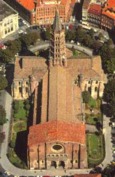

France, Toulouse, St. Sernin, c. 1080-1120,
cathedral. An aerial view photograph of St. Sernin from one
angle (the tower
dates from 1250; its spire of 1478 belongs to the Gothic period) and from another angle.
![]()

A photo of the nave of St. Sernin.

An axonometric projection of the nave of this
Romanesque cathedral.
![]()

French, An Apostle, sculpted as a relief
in a niche in St. Sernin,
1090. This figure's
solidity and massiveness show references to classical
sculpture.
Its frontality shows a Byzantine
reference, while its massiveness and bulk indicate that it was
intended to be seen from a distance.

The capital of a column at St. Sernin.
![]() See
aerial view, apse,
axonometric projection,
capital, chapel,
column, crossing,
cruciform, nave,
and plan.
See
aerial view, apse,
axonometric projection,
capital, chapel,
column, crossing,
cruciform, nave,
and plan.

![]()

France, Conques, Tympanum over the entrance
to the Abbey Church of Sainte-Foy,
mid-11th-12th century, Romanesque. The subject
of this tympanum is Christ
presiding at the Last Judgment. A photo of Sainte-Foy, as seen from the hills
above it, and another of Sainte-Foy's nave.

Germany, Lower Saxony, c. 1160 / 70, Communion
Chalice, ("Wilten Chalice"), silver partially gilt,
with niello, height
16.7 cm, Kunsthistoriches Museum, Venice. See chalice.
An excavated marble column, Corinthian style capital with its impost block from a late Romanesque cloister, as revealed at the Psalmodi excavation site. See capital, column, impost block, and marble.
Romanitas - The religion of the Roman empire before the supremacy Christianity. The practice of Romanitas was based on imperial dominion.
(pr. roh-MAH-nee-tahs)
Also see Roman art.
rondel or roundel or rondelle - Any circular work of art or other object, or a circular element of a work, design or symbol. Sometimes seen in heraldry, architecture, and iron-work, for instance.
Examples:

Iran, Decorative Roundel, 11th century,
gold sheet, wire, formerly set with gemstones,
diameter 3 inches (7.7 cm),
Cincinnati Art Museum, OH. See Islamic
art and jewelry.

Filippo Brunelleschi (Italian, 1377-1446),
detail of rondels on the exterior of the Hospital
of the Innocents (Ospedale degli Innocenti), 1419, glazed
terra cotta, Florence, Italy.
Or, the term may refer specifically to a disk of glass.
Also see kaleidoscope, mandala, rosette, rose window, rotunda, stained glass, and tondo.
rondo - See tondo.
Rorschach test - In psychology, a test in which a person's interpretations of inkblots
are analyzed as a measure of personality — ![]()
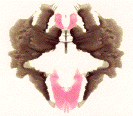 "intellectual
and emotional functioning and integration." (pr. ROHR-shahk)
"intellectual
and emotional functioning and integration." (pr. ROHR-shahk)
Although inkblots are invariably symmetrical, making them is largely aleatoric — their images depending greatly upon accident or chance.
Dr. Hermann Rorschach (Swiss psychiatrist, 1884-1922) introduced his test in 1921. Even though its accuracy is questioned, and its continued use has become controversial, it is still employed by psychologists despite serious questions of its utility. Painted versions of inkblots are called blotto paintings.
Related link:
Also see fanciful, fantastic, fantasy, gestalt, oneiric, sign, Surrealism, and symbol.
rosette - An ornament, often painted and / or sculpted, having a circular (radial) arrangement of parts resembling rose petals, more or less.
(pr. ROH-zet)
Examples:

Rosette from the ancient Temple of Jupiter,
Capitoline Hill, Rome, from a hand-colored engraving published by Carlo Antonini
in 1781, plate 12. The Temple of Jupiter was the principal religious
structure of ancient Rome. Although this architectural feature
may have been colored in its original state, the colors in this
engraving are highly speculative. The enlarged view includes
a cross-section of the rosette.
This is one of a set of 100 engravings, some of which can be
purchased from lombardmaps.com.

Rosette from the ancient Temple of the Sun,
17-130 CE,
Palmyra, Syria, from a hand-colored engraving published by Carlo Antonini
in 1781, plate 3. The Temple of the Sun is also known as the
Temple of Baal. Its colonnade is nearly 1.6 km (1 mi) long, with
about 1500 Corinthian columns. Although this architectural
feature may have been colored in its original state, the colors
in this engraving are highly speculative. The enlarged view includes
a cross-section of the rosette.

Rosette from ancient Roman fragments,
from a hand-colored engraving
published by Carlo Antonini in 1781, plate 39. Although this
architectural feature may have been colored in its original state,
the colors in this engraving are highly speculative. The enlarged
view includes a cross-section
of the rosette.

Rosette from ancient Roman fragments,
from a hand-colored engraving
published by Carlo Antonini in 1781, plate 46. Although this
architectural feature may have been colored in its original state,
the colors in this engraving are highly speculative. The enlarged
view includes a cross-section
of the rosette.

Rosette from ancient Roman fragments,
from a hand-colored engraving
published by Carlo Antonini in 1781, plate 49. Although this
architectural feature may have been colored in its original state,
the colors in this engraving are highly speculative. The enlarged
view includes a cross-section
of the rosette.
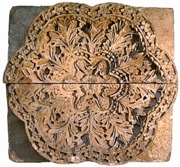
Jordan, Rosette from the Palace of Mschatta,
mid-8th century, limestone
relief, Museum für Islamische
Kunst, Berlin. The design of this
of architectural
ornament incorporates elements
from ancient traditions,
and includes acanthus leaves
and strings of pearls. See Islamic
art.

India, Mughal dynasty,
Shamsa (Rosette) bearing the name and titles
of the Emperor Shah Jahan (reigned 1628-58), illuminated page, 17th century, ink,
colors, and gold on paper,
15 3/16 x 10 7/16 inches (38.6 x 26.5 cm, Metropolitan Museum
of Art, NY. A shamsa (literally, sun) is a form of illuminated
bookplate, that traditionally
opened imperial Mughal albums. Here, the center of the design is a calligraphic pattern
intertwining the official imperial name and titles of Shah Jahan.

Rosette from the Palazzo Borghese, Rome,
1590, from a hand-colored engraving
published by Carlo Antonini in 1781, plate 32. Although this
architectural feature may have been colored in its original state,
the colors in this engraving are highly speculative. The enlarged
view includes a cross-section
of the rosette.
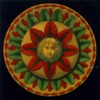
Rosette from the Villa Borghese, Rome,
1590, from a hand-colored engraving
published by Carlo Antonini in 1781, plate 34. Although this
architectural feature may have been colored in its original state,
the colors in this engraving are highly speculative. The enlarged
view includes a cross-section
of the rosette.

Rosette from the Villa Albani, Rome,
1760, from a hand-colored engraving
published by Carlo Antonini in 1781, plate 31. Although this
architectural feature may have been colored in its original state,
the colors in this engraving are highly speculative. The enlarged
view includes a cross-section
of the rosette.
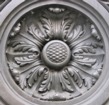
John H. Duncan (American), Rosette, detail of the Soldiers and
Sailors Monument, c. 1885, New York, NY. Dedicated to Union
servicemen who died for their country in the American Civil War.
See monument.
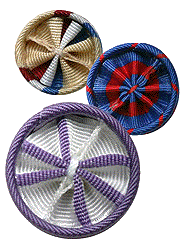
Dexter Schierenbeck (American, 1921-), Rosette for Descendants of the Signers of the Declaration of Independence (top); Rosette for the University of Pennsylvania Trustees Council; and Rosette for Northwestern University, textile, each is comparable in size to a button. In early 19th century France, a solid red rosette identified the wearer as a member of Napoleon's Legion of Honor. The custom came to the United States in the late 1800's. Typically the members of the various organizations which distribute such rosettes wear them only to official gatherings, because wearing them on other occasions might be considered pretentious.
Also see boss, compass rose, mandala, rose window, rondel or roundel, and tondo.
rose window - Large circular windows, with a radially balanced design of tracery and stained glass found in Gothic cathedrals. Also called a wheel window.
Examples:

France, Rose Window of St. Denis Abbey Church, interior
view, 1137-1144, near Paris. St. Denis is the burial place
of the kings of France.

France, Rose Window of the Cathedral of Notre
Dame of Paris, interior view.
![]()

![]()
Exterior view showing the fine stone tracery.
Work on this cathedral began in 1163 and was completed 1345. See architecture.

Bernard de Soissons (French, 13th century),
the Rose Window on the front facade of Notre
Dame de Reims, exterior view. The cathedral was begun in
1210, added to and modified during many periods since. See a view of the entire front facade.
![]()

![]()
France, the Rose Window of the North Transept of Chartres
Cathedral, c. 1221. See labyrinth.

England, the Rose Window of Yorkminster, interior view.
The stonework in this rose window dates from 1240. The glass
was added in the 1480s to honor England's Tudor royal family.

Louis Comfort Tiffany (American, 1848-1933),
the Rose Window of First Unitarian Church of
Cincinnati, 1900, located in the front of the church's sanctuary.
Along the periphery at the seven virtues of Truth, Love, Patience,
Freedom, Righteousness, Courage, and Justice. See a photo of this window in situ.
Related links:
Also see fenestration, mandala, rosette, and roundel.
(pr. RAH-zən)
rottenstone - A soft, decomposed limestone. In powder form, rottenstone is used to clean and polish photographs for retouching.
Also see abrasive.
rotulus - A long manuscript scroll. Rotuli were used by the Egyptians, Greeks, and Romans, among others. There were predecessors to codices in the evolution of books.
rotunda - In architecture, a round building, hall, or room, usually with a domed ceiling. The entrances of public buildings, such as museums, are often of this shape.
![]()

![]()
rouge - A reddish powder or compound, chiefly ferric oxide, used to polish metals or glass.
rouge paper - Red paper, similar to carbon paper. It is used for transferring drawings, the red marks easily removed.
Also see copy, tracing, and transfer paper.
roundel - See rondel.
round, sculpture in the - Sculpture which is free-standing and fully developed from all points of view.
roving - A light rope made of loosely bonded glass fiber, used as reinforcement for resin sculpture.
Royal Academy or Royal Academy of Arts (RA) - In 1769, under the patronage of Britain's King George III, the Royal Academy met for its first session. The official title of this elite institution is "Royal Academy in London for the Purpose of Cultivating and Improving the Arts of Painting, Sculpture, and Architecture," but most people who know it, including its members, simply call it "The R.A." The painters among the R.A.'s founding members were its first president, Sir Joshua Reynolds (1723-1792), the portraitist Thomas Gainsborough (1727-1788), the landscapist Richard Wilson (1713/14-1782), and Benjamin West (1738-1820), an American of the colonial period, who became president upon Reynolds' death. Members of the Royal Academy of Arts (RA) are known as "associates", or more formally, "Associate of the Royal Academy" (ARA), and often place the initials "ARA" after their signatures. The Royal Academy owns a collection of masterful works produced by its members since the 18th century, and displays this collection in its galleries.
Also see academy, artists' organizations, English art, history painting, Neoclassicism, and Romanticism.
rubbing - See abrasive and frottage.
rubbing compound - An abrasive paste used to rub down the surface of a resin sculpture to give it a polished finish.
Rube Goldberg - Refers  to
any device reminiscent of those drawn
by American cartoonist Reuben
(Rube) Goldberg (1883-1970). Each of Goldberg's inventions typically
accomplished some task by an extraordinarily complicated and humorous
means. Published as the "Crazy Inventions" in American
newspapers, his drawings
pictured an assemblage
of ordinary objects, mechanical
gadgets, and the oddest odds and ends linked together to perform
simple operations. A "Rube
Goldberg device" then, must be an incredibly impractical
scheme or contraption, accomplishing by complex
means what could have been done quite simply.
to
any device reminiscent of those drawn
by American cartoonist Reuben
(Rube) Goldberg (1883-1970). Each of Goldberg's inventions typically
accomplished some task by an extraordinarily complicated and humorous
means. Published as the "Crazy Inventions" in American
newspapers, his drawings
pictured an assemblage
of ordinary objects, mechanical
gadgets, and the oddest odds and ends linked together to perform
simple operations. A "Rube
Goldberg device" then, must be an incredibly impractical
scheme or contraption, accomplishing by complex
means what could have been done quite simply.
Related resources:
Also see absurd, incongruity, signature, and technology.
Rubénisme - The doctrine that color, rather than form, was the most important element in painting. A movement in seventeenth century France which highly valued the coloristic brilliance and painterly style of Peter Paul Rubens (Flemish, 1577-1640), in reaction to Poussinisme, which highly valued the prominence of drawing and the linear style of Nicolas Poussin (French, 1593/94-1665). Rubens, Poussin, the Rubénistes, and the Poussinistes were all active during the Baroque period of art.
Here are examples of paintings by Rubens:

Peter Paul Rubens (Flemish, 1577-1640), The Three Graces, oil
on wood panel,
(221 x 181 cm), Prado Museum, Madrid.
Peter Paul Rubens, Isabella Brant, c. 1620, oil on wood panel, Cleveland Museum of Art.

Peter Paul Rubens, Bacchus, 1638/40, oil
on canvas (transferred from
panel), 75 x 63 1/2 inches (191 x
161.3 cm), Hermitage Museum, St. Petersburg, Russia.

Jacob Jordaens (Flemish, 1593-1678), The Bean King, c. 1638, oil
on canvas (transferred from
old canvas), 62 x 83 inches (160 x 213 cm), Hermitage Museum,
St. Petersburg, Russia.
Here are examples of paintings by Poussin, and the leader of the Poussinistes, Charles Lebrun:

Nicolas Poussin (French, 1593/94-1665), Parnassus, oil
on canvas, 145 x 197 cm, Prado
Museum, Madrid. Also see Poussinisme.
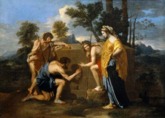
Nicolas Poussin, Arcadian Shepherds (Et in Arcadia Ego),
aka Les Bergers d'Arcadie, Louvre.
This painting has special significance to those who are interested in the theories propounded in the recent best-selling novel The Da Vinci Code, and elsewhere, concerning the (supposed) truth about the Holy Grail (or Sangre Royal ) — a secret kept by the Knights Templar and a mysterious society called the Priory of Zion, or Prieure de Sion. The Priory is said to have been headed at various times by such men as Jacques DeMolay, Leonardo da Vinci, Isaac Newton, Claude Debussy, and Jean Cocteau. Poussin is said to have been one of this society's members, and to have left a clue in this painting. The mountains in the painting are said to represent a range seen near the village of Arques, in the region of Languedoc. One of the shepherds in it points to words carved into a tomb: "Et in Arcadia Ego" . . . In Arcadia I am. The tomb is said to have actually existed near Arques, but it is no longer there, having been suddenly demolished in the late 1960's under mysterious circumstances. The reason: supposedly people were too close to learning the truth of the mystery of the Holy Grail . . . the Sangre Royal. The secret that many powerful people do not want you to know: descendants of a child begat by Christ and Mary Magdalene either lived or continue to live in France to this day.
![]()

Charles Lebrun (French, 1619-1690), Alexander and Porus, 1673, oil
on canvas.
rugosity - A surface texture that is wrinkled, creased, or ridged.
(pr. roo-GAH-sə-tee)
Generally unwanted in paintings,
rugosity ![]()
 can
develop for any of several reasons, although it is much less likely
to occur while using good quality artist's materials.
Likely causes include:
can
develop for any of several reasons, although it is much less likely
to occur while using good quality artist's materials.
Likely causes include:
Also see boss, dent, emboss, fluted, fold, kerf, permanence, pleat, and repoussé.
rule of compensation - A guideline for balancing a composition that states that the bigger the mass, the more toward the center of an artwork it should be placed. Similarly, the smaller the mass, the more toward the edge it should be placed.
runner - In lost-wax casting, a channel in the mold through which the molten metal flows into the mold from a funnel or runner cup. Channels are made by attaching wax rods to a wax model prior to investment. When the mold is full, the runners fill with metal too. They must then be sawn off and filed. Occasionally they have been incorporated into the design of the final work, and not sawn off. A common example is the tang descending from the base or lowest portion of a sculpture, which is employed to secure the sculpture to its pedestal.
Also see risers, rodding, and sprue.
rush - Rush is a paper material which resembles a rope 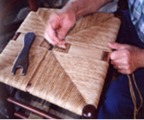 or cord. It has a distinctive helical
twist to it and can be unraveled. Rush was developed in the late
19th century as a substitute for rattan
in wicker furniture,
occasionally called paper fiber reed wicker. Sometimes a wire
core is added to rush to increase its strength. A woven
fabric of rush, called Lloyd loom paper fiber rush has been available
since the early 20th century, largely used in the manufacture
of wicker furniture. Alternatives to rush might include Oriental
seagrass and Danish cord.
or cord. It has a distinctive helical
twist to it and can be unraveled. Rush was developed in the late
19th century as a substitute for rattan
in wicker furniture,
occasionally called paper fiber reed wicker. Sometimes a wire
core is added to rush to increase its strength. A woven
fabric of rush, called Lloyd loom paper fiber rush has been available
since the early 20th century, largely used in the manufacture
of wicker furniture. Alternatives to rush might include Oriental
seagrass and Danish cord.
Examples:

Warrington Taylor (English), for Morris &
Company, Sussex
chair, c.1886, ebonized oak with woven rush seats, 33
x 16 x 14 inches. See Arts and
Crafts Movement.

![]()

Tom Dixon (contemporary), manufactured by Cappellini S.p.A., Arosio, Italy, S Chair, 1991, rush and steel, 40 3/8 x 19 1/4 x 22 7/8 inches (102.6 x 48.9 x 58.1 cm), Museum of Modern Art, NY.
Also see basket, bamboo, cane, design, fiber, raffia, reed, and wood.
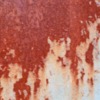
![]()
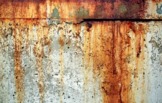
rust - A brown or reddish-brown oxide which forms on iron by corrosion, caused most commonly by exposure to water. A common source of brown pigments.
Here are some digitally-simulated rusted surfaces:
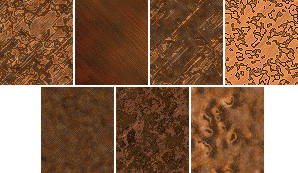
Also see earth colors, finish, galvanize, neutral, patina, sheet metal, steel, surface, and texture.
rustic - Typical of country life or country people. Lacking sophistication or elegance.
Examples of rustic imagery:

Rembrandt Harmensz. van Rijn (Dutch, 1606-1669),
Cottage among Trees, 1648-50, pen and
brown ink, brush and brown washes,
on paper washed
with brown, 6 3/4 x 10 7/8 inches (17.1 x 27.6 cm), vertical
strip 6 3/4 x 1 1/4 inches (17.2 x 3.2 cm) added by artist to
the sheet at right, Metropolitan Museum of Art, NY. See Baroque.

Jacob van Ruisdael (Dutch, 1628-1682), Dune Landscape with Oak Tree, 1650-55,
black chalk, brush and gray wash
and gouache, framing
lines in pen
and brown ink, 8 1/4 x 7
1/2 inches (21.0 x 19.1 cm), Metropolitan Museum of Art, NY.

Heneage Finch, Fourth Earl of Aylesford (English,
1751-1812), In Wales 1795, etching
on paper, image 8.4 x 17.5 cm, Tate
Gallery, London.

John Sell Cotman (English, 1782-1842), A Farmhouse, watercolor on paper,
15.0 x 22.0 cm, Tate Gallery, London.
See buckeye, calendar painting, folk art, Hudson River school, nostalgia, pastoral, picturesque, primitive, and sacral-idyllic scene.
rusticate - In architecture, to give an eroded or rustic appearance by roughening the surface and beveling the edges of stone blocks to emphasize the joints between them. A technique popular during the Renaissance, especially for stone courses at the ground-floor level.
(pr. RU-stə-kayt)
Examples:

Roman, Porta Maggiore, a detail of rusticated masonry.
![]()
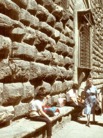
Michelozzo di Bartolommeo (Italian architect),
Palazzo Medici-Riccardi, begun 1444. The ground-floor of this urban palace was constructed
with deeply rusticated masonry, giving it the look of an old
fortress.

The second
story of the Palazzo Medici-Riccardi has a much smoother
texture, as you can see in
comparing it to the first story. Its third story is the smoothest
of the three.
Also see Cyclopean.
https://inform.quest/_art